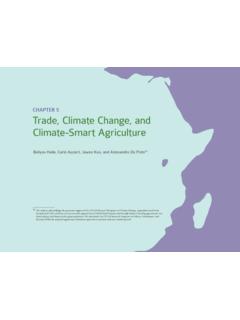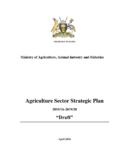Transcription of Climate-Smart Agriculture in Costa Rica + vr - …
1 Climate-Smart Agriculture in Costa Rica Climate-Smart Agriculture (CSA) considerations A Efficient irrigation and drainage systems are Producers organizations play an important role in essential responses to increasingly irregular rainfall promoting CSA among their members and enabling P patterns over large parts of the country. cross-sectoral collaboration. They also play a leading role in ongoing research on climate trends, drought- A The provision of improved weather information and pest-resistant crop variety development, and new services will facilitate informed decision making by agricultural practices adapted to changing climate P producers. conditions. A A growing public concern is the high rates of The identification of suitable adaptation and agrochemical usage by Costa Rican farmers.
2 Efficient mitigation options can be enhanced by development M use of agrochemicals can reduce costs, improve and access to Integrated Decision Support Systems farmers' responses to unpredictable weather patterns, that compile and analyze weather, agronomic, and and contribute to mitigation efforts by reducing market information, and deliver results to a range of nitrogen emissions. stakeholders and decision makers. A Rotational grazing and forage banks increase the $ The established PES program provides an incentive resilience of livestock production systems to drought. for the development of agroforestry and silvopastoral M They can help improve efficiency, thereby reducing systems. In addition, there are opportunities to methane emissions per unit of production.
3 Build on Costa Rica's experience of participating in emissions-trading schemes by developing initiatives A Agroforestry is already well established in the coffee that explicitly promote the adoption of CSA practices sector. Carbon-capture coffee agroforestry systems by small-scale producers. M. can improve resilience to drought and disease, while increasing incomes through product diversification $ The family farm sector is currently underperforming and payments for environmental services (PES). in comparison with industrial Agriculture , making it a priority to expand support for CSA development Nationally Appropriate Mitigation Actions (NAMAs) on small farms by replicating existing pilot projects for the different agricultural subsectors are an effective and accessing new sources of funding.
4 Reinvigoration means of operationalizing Costa Rica's climate of the small-farm sector can also make a significant change policy instruments and help promote inter- contribution to the country's food security, which at agency collaboration. present relies heavily on imports to meet basic needs. A Adaptation M Mitigation P Productivity Institutions $ Finance T he Climate-Smart Agriculture (CSA) concept reflects an ambition to improve the integration of Agriculture development and climate responsiveness. It aims to that address challenges in environmental, social, and economic dimensions across productive landscapes. While the concept is new, and still evolving, many of the achieve food security and broader development goals practices that make up CSA already exist worldwide and under a changing climate and increasing food demand.
5 Are used by farmers to cope with various production risks CSA initiatives sustainably increase productivity, [2]. Mainstreaming CSA requires critical stocktaking of enhance resilience, and reduce/remove greenhouse ongoing and promising practices for the future, and of gases (GHGs), and require planning to address tradeoffs institutional and financial enablers for CSA adoption. and synergies between these three pillars: productivity, This country profile provides a snapshot of a developing adaptation, and mitigation [1]. The priorities of different baseline created to initiate discussion, both within countries and stakeholders are reflected to achieve countries and globally, about entry points for investing more efficient, effective, and equitable food systems in CSA at scale.
6 National context: Key facts on Agriculture and climate change Economic relevance of Agriculture People and Agriculture Agriculture is a key sector in the Costa Rican economy;. however, the steady development of manufacturing and service industries means that the country's economy is no longer as reliant on Agriculture as it was in the past. Services, including tourism, are the largest economic sector in Costa Rica, accounting for more than 70% of the gross domestic product (GDP) [3]. The manufacturing sector accounts for just over 20%. Principal industries include microprocessors and medical equipment. Much of this economic activity takes place in the free-trade zones (FTZs). Agriculture still makes a substantial contribution to the country's export earnings and, together with tourism and electronic products, is one of the country's top three export earners [4].
7 The value of primary agricultural exports accounts for 22% of the country's total exports Land use (2009 2013) [4]. While Costa Rica exports several hundred During the last five decades, cultivated lands in Costa different agricultural products [5], the most important Rica have not shifted geographically, but the location and sources of export earnings are the products of large-scale type of crops have changed. Grazing land once covered monoculture, notably pineapples and bananas [4]. The almost half the country. In recent years, less productive other principal export crop, coffee, is typically grown by pastures have been abandoned and replaced by forestry small-scale producers under traditional shade systems [6]. plantations or naturally regenerating tree cover.
8 The largest protected areas are located in mountainous The agricultural sector is the second largest source areas, which play an important role in providing water of employment in the country, employing 13% of the and other ecosystem services. Principal land uses are economically active population [3, 7]. Primary Agriculture forests (51%), pastures (25%), and permanent crops (6%). accounts for just 7% of GDP [3, 8] but, if agribusiness is [3]2, mainly coffee and fruit trees. considered, the total contribution of the agricultural sector to GDP rises to 14% [7]. Land Use [4] Main Crops [4]. Costa Rica imports large quantities of fresh and processed foods, accounting for 13% of the total value of imports. In particular, the country relies heavily on imports for the majority of its staple foods, including maize, soybean, wheat, rice, and beans [8].
9 1. Economic Relevance of Agriculture Agricultural production systems Coastal zones are mainly dedicated to industrial scale production of sugarcane and rice, alongside pineapple, bananas, and oil palm. While all these crops are also grown by small-scale producers, these often find it challenging to meet increasingly stringent quality standards and other criteria for participation in export trade [5]. Multinational companies, such as Dole and Chiquita, have a growing 1 See Annex II. 2 See Annex III. 2 Climate-Smart Agriculture in Costa Rica presence as land-owners and producers, particularly of pineapples and bananas. Pineapple is the most dynamic sub-sector, having overtaken bananas as the country's Productivity Indicators highest value crop at the start of the decade [10].
10 Highland areas are dedicated in large part to the production of livestock, together with coffee, fruits, and vegetables [11]. Over 50,000 families in highland areas depend on coffee production: 90% of these are small- and medium-scale producers owning an average area of hectares [6]. Small- and medium-sized farms in highland areas also produce a variety of flowers, fruits, and vegetables, both for home consumption and export. The need for high yields in relatively small areas is one of the main reasons for the high use of agrochemicals. Agricultural GHG emissions Important Agricultural Production Systems The agricultural sector is an important contributor to Costa Rica's GHG emissions, accounting for 37% of the total GHG emissions. According to national data used to prepare the latest National Communication to the United Nations Framework Convention on climate Change (UNFCCC) [12, 13], methane emissions in Costa Rica are derived mainly from livestock (representing 15% of total national GHG emissions, and of total emissions from Agriculture ).






